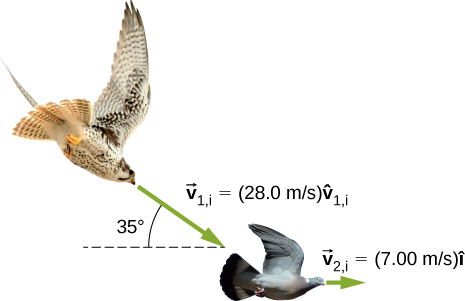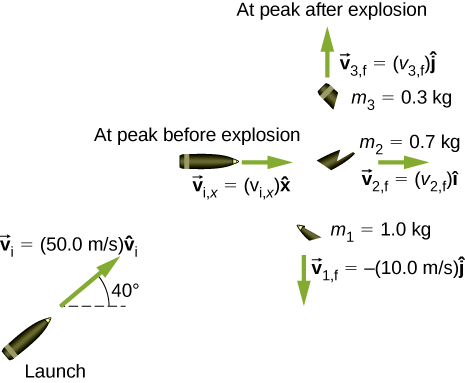| << Chapter < Page | Chapter >> Page > |
Momentum for a system can be conserved in one direction while not being conserved in another. What is the angle between the directions? Give an example.
The angle between the directions must be 90°. Any system that has zero net external force in one direction and nonzero net external force in a perpendicular direction will satisfy these conditions.
A 1.80-kg falcon is diving at 28.0 m/s at a downward angle of . It catches a 0.650-kg dove from behind in midair. What is their combined velocity after impact if the dove’s initial velocity was 7.00 m/s directed horizontally? Note that is a unit vector pointing in the direction in which the hawk is initially flying.

22.1 m/s at below the horizontal
A billiard ball, labeled 1, moving horizontally strikes another billiard ball, labeled 2, at rest. Before impact, ball 1 was moving at a speed of 3.00 m/s, and after impact it is moving at 0.50 m/s at 50° from the original direction. If the two balls have equal masses of 300 g, what is the velocity of the ball 2 after the impact?
A projectile of mass 2.0 kg is fired in the air at an angle of 40.0 to the horizon at a speed of 50.0 m/s. At the highest point in its flight, the projectile breaks into three parts of mass 1.0 kg, 0.7 kg, and 0.3 kg. The 1.0-kg part falls straight down after breakup with an initial speed of 10.0 m/s, the 0.7-kg part moves in the original forward direction, and the 0.3-kg part goes straight up.

a. 33 m/s and 110 m/s; b. 57 m; c. 480 m
Two asteroids collide and stick together. The first asteroid has mass of and is initially moving at 770 m/s. The second asteroid has mass of and is moving at 1020 m/s. Their initial velocities made an angle of 20° with respect to each other. What is the final speed and direction with respect to the velocity of the first asteroid?
A 200-kg rocket in deep space moves with a velocity of . Suddenly, it explodes into three pieces, with the first (78 kg) moving at and the second (56 kg) moving at . Find the velocity of the third piece.
A proton traveling at scatters elastically from an initially stationary alpha particle and is deflected at an angle of 85° with respect to its initial velocity. Given that the alpha particle has four times the mass of the proton, what percent of its initial kinetic energy does the proton retain after the collision?
Three 70-kg deer are standing on a flat 200-kg rock that is on an ice-covered pond. A gunshot goes off and the dear scatter, with deer A running at , deer B running at , and deer C running at . What is the velocity of the rock on which they were standing?
A family is skating. The father (75 kg) skates at 8.2 m/s and collides and sticks to the mother (50 kg), who was initially moving at 3.3 m/s and at 45° with respect to the father’s velocity. The pair then collides with their daughter (30 kg), who was stationary, and the three slide off together. What is their final velocity?
An oxygen atom (mass 16 u) moving at 733 m/s at 15.0° with respect to the direction collides and sticks to an oxygen molecule (mass 32 u) moving at 528 m/s at 128° with respect to the direction. The two stick together to form ozone. What is the final velocity of the ozone molecule?
341 m/s at 86.8° with respect to the axis.
Two cars approach an extremely icy four-way perpendicular intersection. Car A travels northward at 30 m/s and car B is travelling eastward. They collide and stick together, traveling at 28° north of east. What was the initial velocity of car B?

Notification Switch
Would you like to follow the 'University physics volume 1' conversation and receive update notifications?